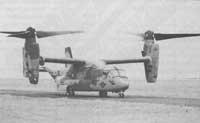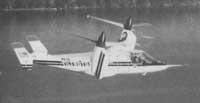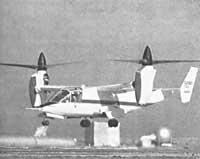Plane and helicopter united
1989/10/01 Otaolaurretxi, Jon Iturria: Elhuyar aldizkaria

Bell Helicopter, based in Arlington, Texas, is a house dedicated to the traditional helicopter, which since 1958 is mainly dedicated to testing aircraft helicopter for military purposes. With the XV-3 and XV-15 models, tests have been carried out over the years and Osprey has been chosen.
Aircraft helicopter with two tiltrotators, one at each end of the wings. When the axes of the rotors are vertically (as in the helicopter), the plane moves vertically up and down, without the need for long airports to take off and land. The civil traveler can pick up the town and place it inside the city, and as for his military applications, he can transport soldiers from anywhere to anywhere.
The idea of tiltrotators is as old as the helicopter, but when it starts to be done in practice the difficulties appear quickly.
On the one hand, to ascend vertically as the helicopter, a rotor of large diameter and low speed is recommended. In this way a greater vertical force of each equestrian power of the engine can be obtained. The “Super Puma” helicopter carried out by Aerospatial, for example, has a rotor of 15.6 meters in diameter and four arms and with an engine of 3000 equestrian powers reaches a vertical force of 9 tons. The maximum peripheral speed of the arms is 270 m/s (lower than the speed of the sound), making the maximum rotation speed of the rotor is 330 rpm.
But the propeller of the plane is different. To obtain a good performance in horizontal translation it is necessary that the diameter is smaller and that the turning speed is greater. For example, the ATR 42 aircraft has a four-arm rotor and a 3-metre axis turning speed is 1,800 rpm. The rotor is powered by an engine of 1,800 horsepower.
In this sense, the force with good vertical and horizontal performance by tilting the same rotor is difficult, but not impossible. In the case of the Osprey model, engineers have worked on all factors to improve performance: arm shape, profile, torsion, length and turning speed. The size of the arms or propellers is variable as in the propellers of the aircraft and are made of “composite” materials (mainly fiberglass).
When in helicopter form, the Osprey model will work just like the other two rotor helicopters, taking advantage of the different side tilt of each rotor. You can ascend and back up to a speed of 65 km/h (walking like crabs) or moving towards 185 km/h, like any other helicopter.
However, in order to move like a plane, the Osprey model has to base its two rotors little by little 90. This operation is the most complex and to be carried out with the largest account. When the rotors are turning, the ideal thing is that at every moment the rotation axis of the rotors is parallel to the velocity vector of the entire apparatus. Otherwise harmful efforts are generated that cause vibrations in the rotors. To solve this problem, numerous tests have been carried out in aerodynamic tunnel and computer simulations. In the Osprey model, the passage of helicopter mode to airplane mode will be done through automatic programs, being the function of the pilot the monitoring and surveillance of the operation.

The Osprey aircraft helicopter, empty, weighs 14.4 tons. It is influenced by two turbomotores (model Allison-T406) of 6.000 Z.P of power each. Each rotor has a diameter of 11.6 m (three arms). The fuselai offers a useful volume of 7,37x1,8x1,83 m, with capacity for 24 soldiers and two light cannons. The applicable load for short displacements is 9 tons. It has tanks for the reception of 6.2 tons of fuel, although it can also prepare for an eventual introduction of 13.4 tons.
The rotor can vertically lift a total of 21,5 tons and the rotor tilted forward about twenty degrees 25 tons. The maximum displacement speed is 580 km/h, but normally at 9,000 meters of height is reached a speed of 500 km/h. It is twice the speed of normal helicopters, but the helicopter has a better performance by climbing the cargo vertically.
This aircraft helicopter has another peculiarity. It is manufactured almost entirely with “composite” materials and has less than 500 kg of metal in its structure.
The US army began receiving the first Osprey aircraft helicopters in 1992. For the air, maritime and terrestrial armies a total of 552 devices will be served.
The European Economic Union plans to use this type of equipment in civil transport and has begun financing the first investigations through the Eureka program. The European civil version of this device, known as “Eurofar”, will have capacity and space to transport thirty passengers.

Gai honi buruzko eduki gehiago
Elhuyarrek garatutako teknologia




